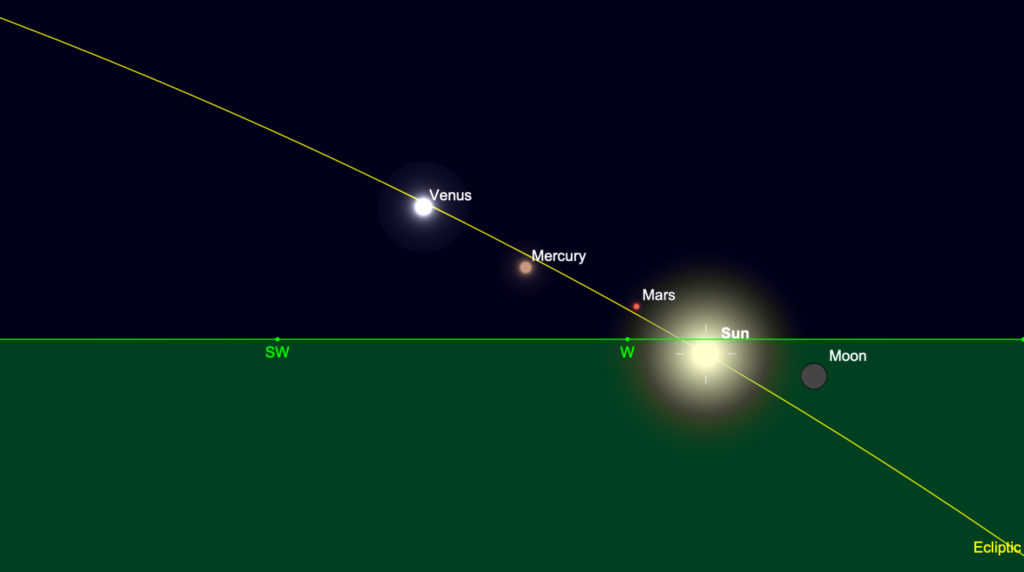Sky Report August 30 – September 5

The ecliptic – yellow line – is the plane of the solar system. The sun is on it and the planets and moon are near it. Here we see below the horizon. This is for 8 p.m. MDT on September 5th. Graphic created with SkySafariAstronomy.com.
Venus and Mercury both appear in the west shortly after sunset. Venus is brilliant and easy to see for about 90 minutes after sunset, but this is a poor evening appearance of Mercury and you’ll have trouble spotting it. The angle that the plane of the solar system and the path of the planets – the ecliptic – makes with the horizon changes through the year, and now it makes a shallow angle. Although Mercury is a fair distance from the sun all month, it’s very near the horizon and I don’t recommend even trying to look for it unless you have a computerized telescope. Venus, in contrast, is especially pretty, especially if there are sunset colors or foreground features in the landscape.
The bright star near Venus on the 4th and 5th is Spica, and on those nights Spica is less than 2°, the width of a finger held at arm’s length, to the lower left of Venus. Although Spica, which is in Virgo, is one of the brightest stars, Venus outshines it by 5 magnitudes or 100 times. Watch for several nights and again you have a fine opportunity to watch a planet move as it orbits the sun.
Jupiter and Saturn are visible all night, forming an obvious pair that is in the southeast at sunset and a third of the way up the southern sky at midnight. Jupiter is the brighter of the two, and both are in Capricornus. It will be almost 20 years before both planets lie in the same constellation.
The next two weeks, while the moon is out of the way, is the best time to see the glow of the zodiacal light. This is light reflected off tiny interplanetary dust particles that lie in the plane of the solar system (along the ecliptic) that come from comets and asteroid collisions and, as discovered earlier this year, perhaps also from Mars. Look for a soft, faint, hazy pyramid of light in the morning sky stretching up from the eastern horizon through Cancer, Gemini, and Taurus. It resembles the Milky Way and you’ll need to observe from a dark location; the zodiacal light can be obvious once you know what to look for. It appears in the morning sky now and in the evening sky in spring. Trivia: the doctoral thesis of Brian May, guitarist of the rock band Queen, was on zodiacal dust.
Under a grant from the Utah Governor’s Office of Economic Development and the Kane County Office of Tourism, Stellar Vista Observatory offers portable telescopes and tripod mounted binocular kits on loan for free to all residents of Kane County. Nothing beats a quality binocular or astronomical telescope to enhance enjoyment of the night sky! Visit https://stellarvistaobservatory.org/discover-the-night-sky/ for full details, or drop by Kanab City Library and have a look at one of the kits.
The Sky Report is presented as a public service by the Stellar Vista Observatory, a nonprofit organization based in Kanab, Utah, which provides opportunities for people to observe, appreciate, and comprehend our starry night sky. Additional information is at www.stellarvistaobservatory.org. Send questions and comments to John@StargazingAdventures.org.





Comments are closed.